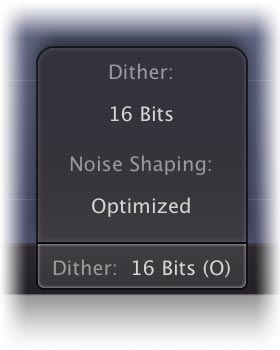FabFilter Pro-L 2 online help
Table of contents
Go to sectionFabFilter Pro-L 2 Help
Introduction
Using FabFilter Pro-L 2
Full Screen mode, resizing and scaling
Presets
Purchasing FabFilter Pro-L 2
Support
Dithering and noise shaping
In modern music production, most people are used to working with 24-bit audio to preserve as much resolution and precision as possible. Plug-ins usually work with 32-bit or 64-bit floating-point sample values. However, the audio that finally ends up on a normal CD only uses 16 bits of resolution. This means that at some point, the bit depth has to be reduced to suit the final medium.
The simplest way to reduce the bit depth of an audio signal, is to just truncate the least significant bits of every sample. However, this causes quantization distortion (in the form of unwanted harmonics) in the resulting audio. The best way to avoid this distortion, is by adding a tiny bit of white noise to the audio signal before truncating any bits. This eliminates the nasty quantization distortion at the cost of a slightly higher noise level in the final audio. This is called dithering.
To make the effect of applying dithering noise less audible in the final audio (in other words: to improve the signal-to-noise ratio), we can filter the noise introduced by the dithering process. That way, we don't end up with plain white noise (having a flat spectrum), but with noise that is less audible at frequencies where the human ear is most sensitive.
Dithering in FabFilter Pro-L 2
In the bottom bar of FabFilter Pro-L 2's interface, you'll find the dither settings panel. With two simple controls, you can specify your prefered dithering and noise shaping settings:

- The Dither setting specifies the desired bit depth of the resulting audio. You can choose to dither/quantize to 24, 22, 20, 18 and 16 bits. Of course, if you don't want any dithering, quantization (or noise shaping) to occur, just choose 'Off'.
- The Noise Shaping setting lets you choose between various noise shaping
algorithms:
- The Basic setting lowers the overall noise floor a few dB, at the cost of increasing noise levels for frequencies above 6 kHz.
- With the Optimized setting, the effect is more extreme; you'll get an even lower overall noise level, but noise frequencies above 10 kHz are boosted more extremely.
- Weighted noise shaping will transform the noise spectrum according to the ear's sensitivity to certain frequencies at low listening levels. Theoretically, this results in the lowest audible noise. This noise shaping setting is designed to be used at 44.1 kHz. It still works at other sample rates, but the frequency spectrum of the resulting noise isn't optimal anymore.
Note that the Dither button in the bottom bar will show the current target bit depth, plus an additional letter that indicates the chosen Noise Shaping setting, e.g. "20 Bits (W)".
Myths and facts
Theoretically, dithering the best way to retain as much resolution as possible when quantizing your audio. However, in the real world, dithering often has little to no audible effect. Here are a few things to keep in mind:
- Although loudness normalization is becoming more and more common, much of today's music is still mastered at quite loud (if not ridiculously loud) average levels, leaving very little dynamics in the final result. This already masks the small level of distortion due to quantization, so dithering probably won't have any audible effect.
- A lot of audio recordings already have a relatively high noise floor, due to the use of microphones, amplifiers, analog outboard, mixing consoles etc. In that case, dithering will have no beneficial effect at all; it will just increase the existing noise floor.
- Dithering should only be used as the final stage of audio processing/mastering. With any further processing, like gain changes, applying effects, or converting to yet another bit depth, the effects of dithering will be lost. If your host offers a post-gain effect insert slot on the master channel, use this slot for FabFilter Pro-L 2 when dithering is enabled.
- Dithering more than once doesn't make any sense. It will just increase the overall noise level in your audio.
- When mastering for lossy formats as AAC/MP3, dithering doesn't make much sense. These formats don't have a fixed bit depth, and are usually created from a 24-bit input master anyway.
So when should you use Pro-L 2's dithering? The rule of thumb would be: when you use FabFilter Pro-L 2 in the final stage of mastering (for CD), handling audio with a very low noise floor of itself, and the end result is still fairly dynamic. But the most important advice of all is... use your ears!
Notes
- The white noise used for dithering in FabFilter Pro-L 2 is the industry-standard TPDF noise, 2-bit peak-to-peak.
- To read more on dithering, see Dithering
 and
Noise shaping
and
Noise shaping
 on Wikipedia.
on Wikipedia.
Next: Input and output options
See Also
Overview
Recommended workflow
